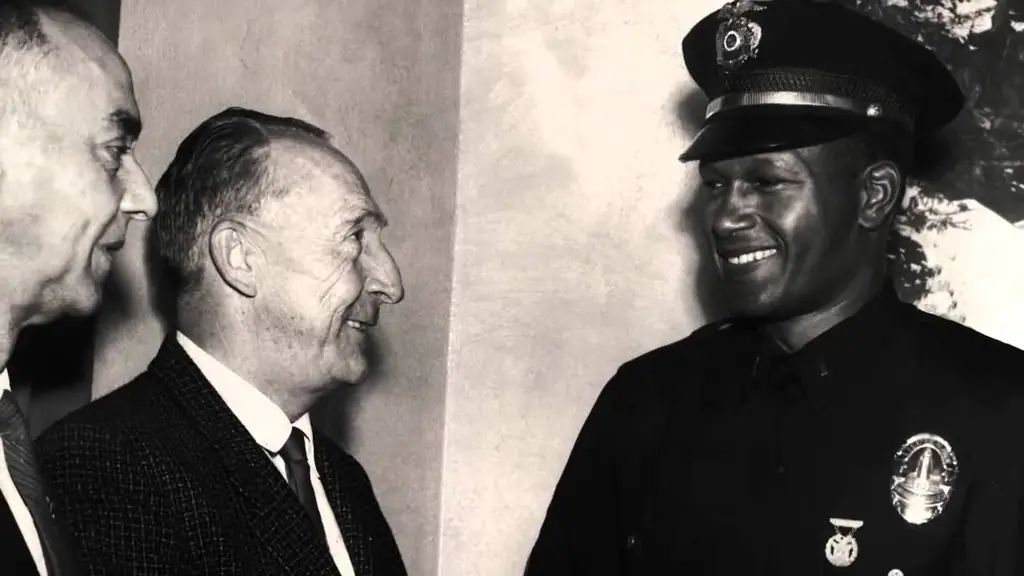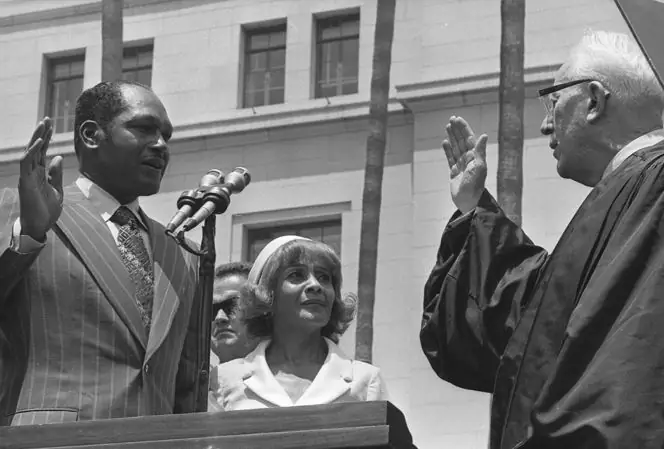- Author Antonio Harrison [email protected].
- Public 2023-12-16 07:44.
- Last modified 2025-01-22 21:44.
Tom Bradley is an American politician who served as mayor of Los Angeles for twenty years (1973-1993). As a representative of the black population, he paid a lot of attention to the fight against interracial intolerance. He made a huge contribution to strengthening the financial well-being of the city. Californian historian Kevin Starr described him as follows: “Tom Bradley was the greatest public figure. I don't know anyone who has a great gift for reconciliation and healing."

Biography: childhood, family, school years
Thomas Bradley was born on December 29, 1917 in a poor peasant family who lived near the city of Calvert, Texas. His parents worked on rented land, and gave part of the harvest to the landowner. Tom's grandfather was a slave. In search of a better life, the family moved to Arizona to pick cotton. Of course, little Bradley was also brought in for all possible help.
In 1924, the move followed again, this time the family settled in Los Angeles. Father got a job on the Santa Fe railway, mother worked as a maid. Many years later, Tom Bradley recalled how, after the divorce of their parents, they lived for some time on state aid. In addition to him and his older brother Lawrence, three more children remained in the care of the mother - two younger sisters and a brother. In addition, one of the girls - Ellis - had cerebral palsy.
During his elementary and high school years, the boy often heard that he didn't need to go to college. However, his fate was predetermined by the sporting success that Tom demonstrated in the classroom at the Recreation Center next door to his home. There, the boy was noticed by Ed Leahy, an athletics coach at the Polytechnic High School. Under his patronage, Bradley went there to study, although blacks in this educational institution did not favor.
Despite the difficulties and racial prejudices, Tom became a real star in the new place. He led the school athletics team, demonstrating outstanding success in running, long jump and relay competitions, played for the football team. Bradley was admitted to the Ephebians for his outstanding athletic performance. In addition, he was elected president of the school's Poly Boys' League. Before him, no dark-skinned student had ever sought such recognition.
Student years and early career
Thanks to the athletic scholarship, Tom Bradley has the opportunity to continue his studies at the University of California Los Angeles. He enrolled there in 1937 and joined the Kappa Alpha Psi student fraternity, which supports African American youth. During his studies, Tom worked as a photographer for the American comedian Jimmy Durante.

In 1940, Bradley dropped out of college to join the Los Angeles Police Department. At that time, racial prejudice was still strong in American society. This was reflected in the overwhelming advantage of white police officers over blacks: out of 4,000 officers, only 100 are African American. Despite being a spokesman for the law, Bradley was often refused service in shops, hotels and restaurants in the city. The duty of the black police was limited to patrolling only two areas, and they were never assigned with white companions. In the police, Tom Bradley rose to the rank of lieutenant and retired in 1961. Shortly before his dismissal, he graduated from Southwestern Law School, and soon took up the practice of law.
Personal life
Tom Bradley met his wife-to-be, Ethel Arnold, at New Hope Baptist Church. Their wedding took place on May 4, 1941. The couple raised two daughters - Lorraine and Phyllis. Another daughter of a married couple did not live a day after birth.
Tom and Ethel didn't spend much time together. The head of the family worked hard, almost seven days a week. But the rare joint evenings turned into a holiday for them. According to Lorraine Bradley's recollections, her father liked to help her mother in the kitchen with cooking and washing dishes, and at least once a week they found time to play cards.
For many years, the personal drama of Tom Bradley was the fight against drug addiction of the Phyllis daughter. She was arrested several times and even detained for six months.
Political career
During the period of racial intolerance, the couple turned to white intermediaries whenever they wanted to change their area of residence. When they settled in Crenshaw County, Bradley joined the local Democratic Club. This organization was part of the California Democratic Council, which brought together representatives of the white population, including Jewish nationality, and Hispanics.
In 1961, Bradley ran for the 10th arrondissement council, but was defeated. In April 1963, he tries again and becomes the first black elected to the city council. In an interview with a journalist, Bradley said that he would direct his work towards uniting people and creating a public relations commission in the city.

The politician also got the post of mayor of Los Angeles on the second attempt. After losing in 1969, he was victorious in 1973 and was re-elected four more times in a row. Under his leadership, the face of Los Angeles has changed beyond recognition. The city has turned into a large business center of international importance. The most important achievements of Tom Bradley as mayor:
- the city's first gay rights bill (1979);
- hosting the 1984 Summer Olympic Games;
- AIDS Discrimination Act (1985);
- construction and development of business centers Century City and Warner Center;
- construction of a public transport rail system (metro and light rail);
- admission of women and representatives of sexual minorities to work in the city council and city hall;
- establishing civilian control and reforming the Police Department;
- renovation of Los Angeles International Airport.
For his calm, dispassionate behavior, the politician was given the nickname "Sphinx of the City Hall". Tom Bradley twice (1982, 1986) ran for governor of California and lost to his opponent George Deukmejian. He was offered a position in the administration of President Jimmy Carter, but the mayor refused. Nor was he interested in the post of vice president in the 1984 election campaign of presidential candidate Walter Mondale.
In the early 90s, a number of reasons led to the weakening of the political influence of Tom Bradley:
- financial growth provoked traffic jams and destruction of quiet residential areas of the city;
- urban wastewater pollution from Santa Monica Bay and environmental degradation;
- accusations of the mayor of nepotism and financial fraud;
- problems with the expansion of the metro network due to cost overruns;
- support for the controversial Pacific Palisades oil drilling project;
- loss of city council supporters.
At the end of his fifth term, Tom Bradley re-entered the legal profession, specializing in international trade. In 1996, he began to have serious health problems: the former mayor suffered a heart attack and then a stroke. The illness made it impossible for him to speak in public. But Bradley did not stay away from what was happening in the city, occasionally commenting on the line of behavior of the new mayor. He died on September 29, 1998 in a hospital where he was admitted to treat gout. The cause of death was a second heart attack.






